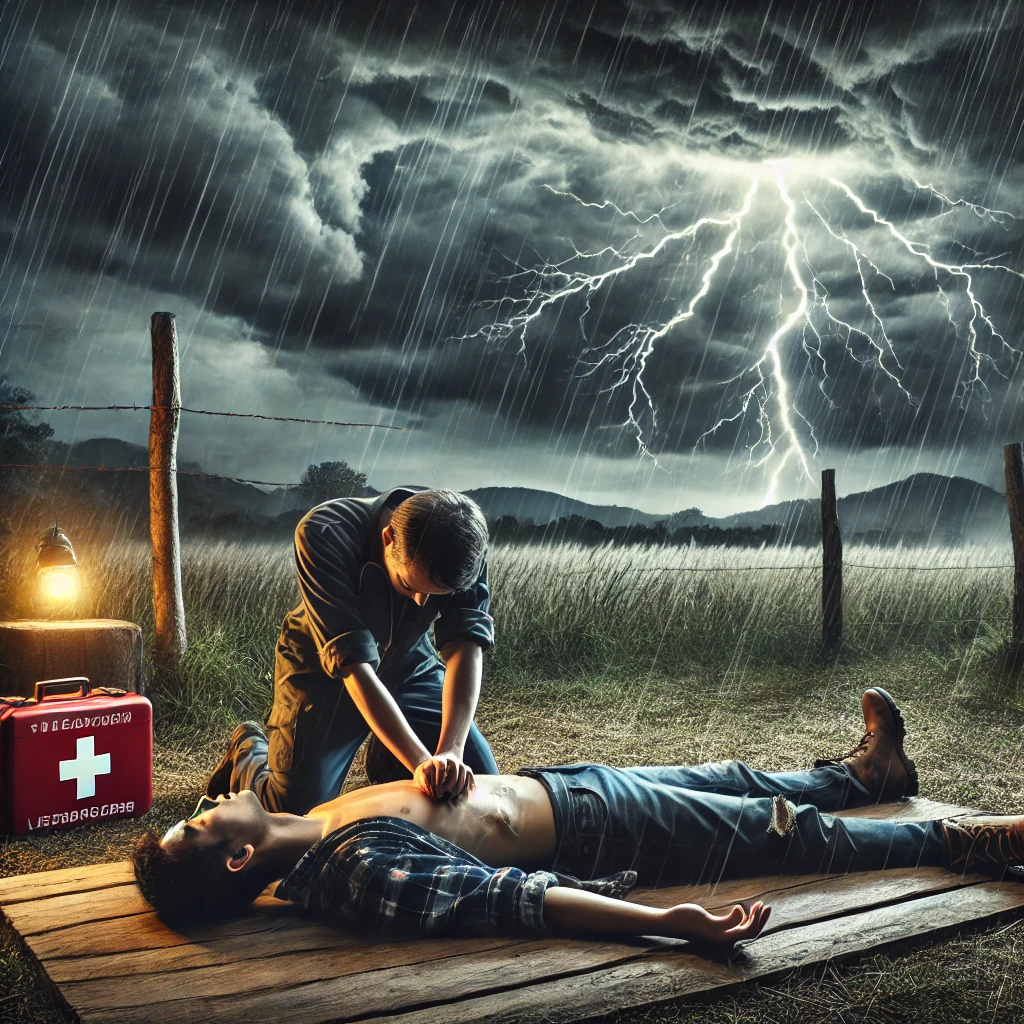Surviving a Lightning Strike: First Aid for the 90% Who Live
A lightning strike is one of the most terrifying and powerful forces of nature. The sheer voltage—up to 1 billion volts—is enough to make anyone believe survival is impossible.
However, survival depends on immediate first aid. Without quick action, lightning strike victims can suffer cardiac arrest, brain injury, and severe burns. Do you know what to do?
What Happens to the Body in a Lightning Strike?
A lightning strike is one of the most intense and extreme forces a human body can experience. A single bolt can carry up to 1 billion volts of electricity—thousands of times more powerful than an electric chair.
Surprisingly, 90% of lightning strike victims survive. But what happens to the body in those split seconds can be devastating.
Let’s break it down.
Step 1: The Impact – A Direct Hit of Extreme Power
A lightning bolt travels at 270,000 mph and reaches temperatures of 50,000°F—five times hotter than the surface of the sun.
If it directly hits a person, the body is instantly overwhelmed by electrical energy, heat, and pressure. The effects begin immediately.
Step 2: The Immediate Effects of a Strike
🔹 Cardiac Arrest & Heart Irregularities
The most deadly effect is an electrical disruption of the heart. A powerful surge can stop the heart instantly or cause dangerous arrhythmias (irregular beats).
🔹 Brain & Nervous System Damage
Lightning travels through nerves and the spinal cord, potentially leading to:
✔️ Seizures
✔️ Memory loss
✔️ Paralysis
✔️ Confusion or unconsciousness
🔹 Lichtenberg Figures – The Lightning Tattoo
One of the strangest effects is the Lichtenberg figure—a reddish, fern-like pattern that appears on the skin. This happens when electrical current bursts through blood vessels, leaving a burn in the shape of branching electricity.
🔹 Blast Injuries & Internal Bleeding
Lightning strikes can also throw victims several feet, causing:
✔️ Broken bones
✔️ Organ damage
✔️ Internal bleeding
Step 3: Heat & Burns
Despite the extreme heat of lightning, most victims don’t catch fire because the heat passes through the body too quickly.
However, it can ignite clothing, melt metal objects, and cause severe burns at entry and exit points.
Common burn areas:
🔥 Head & shoulders (where lightning enters)
🔥 Feet (where it exits)
🔥 Hands, if holding a metal object
Step 4: After the Strike – What Happens Next?
If the victim survives the initial strike, they may experience long-term effects, including:
💥 Chronic pain & nerve damage
💥 Memory loss or brain fog
💥 Hearing or vision problems
💥 Personality changes or PTSD
Some survivors develop a condition called keraunoparalysis, which causes temporary paralysis in the legs due to blood vessel constriction.
First Aid for a Lightning Strike Victim
1️⃣ Check for Danger
Lightning can strike twice in the same spot. Before helping, make sure you’re safe from ongoing storms.
2️⃣ Call 911 Immediately
Even if the person looks okay, they need medical attention. Internal injuries may not be visible.
3️⃣ Start CPR If Necessary
If the victim isn’t breathing or has no pulse, begin CPR immediately.
💔 No pulse? Do hard and fast chest compressions at 100-120 beats per minute.
💨 Not breathing? If trained, give rescue breaths.
💡 Did you know? Lightning strike victims don’t carry an electrical charge. You can and should touch them to provide CPR.
4️⃣ Treat for Shock
Shock can set in quickly. To prevent further complications:
✔️ Lay the person on their back.
✔️ Elevate their legs slightly.
✔️ Cover them with a blanket to keep them warm.
5️⃣ Look for Burns or Injuries
⚡ Check for burns—especially where lightning entered and exited the body.
⚡ If the person is unconscious but breathing, place them in the recovery position to prevent choking.
6️⃣ Monitor Until Help Arrives
Lightning victims may regain consciousness but still be at risk. Stay with them and watch for any changes.
Lightning Strike Myths—Busted!
🚫 Myth: If you’re struck by lightning, you won’t survive.
✅ Fact: Most people survive, but quick first aid is crucial.
🚫 Myth: Lightning victims are electrified—you can’t touch them.
✅ Fact: They don’t hold a charge. It’s completely safe to help them.
🚫 Myth: CPR doesn’t help lightning strike victims.
✅ Fact: Many victims survive because of CPR. Their heart may restart with proper chest compressions.
Be Ready—Learn CPR Today!
Emergencies happen in a flash. Would you know how to respond?
Get CPR certified with Arise Safety and CPR and be prepared to save a life—whether it’s from cardiac arrest, choking, or even a lightning strike!
📍 Sign up for a class: Register here
📍 Need group training? Visit our website
📍 Have questions? Contact us!
📧 Email: contact@arisesafety.com
📞 Call/Text: 317-961-1480
Be the one who takes action. Learn CPR. Save lives. ⚡🚑💙





